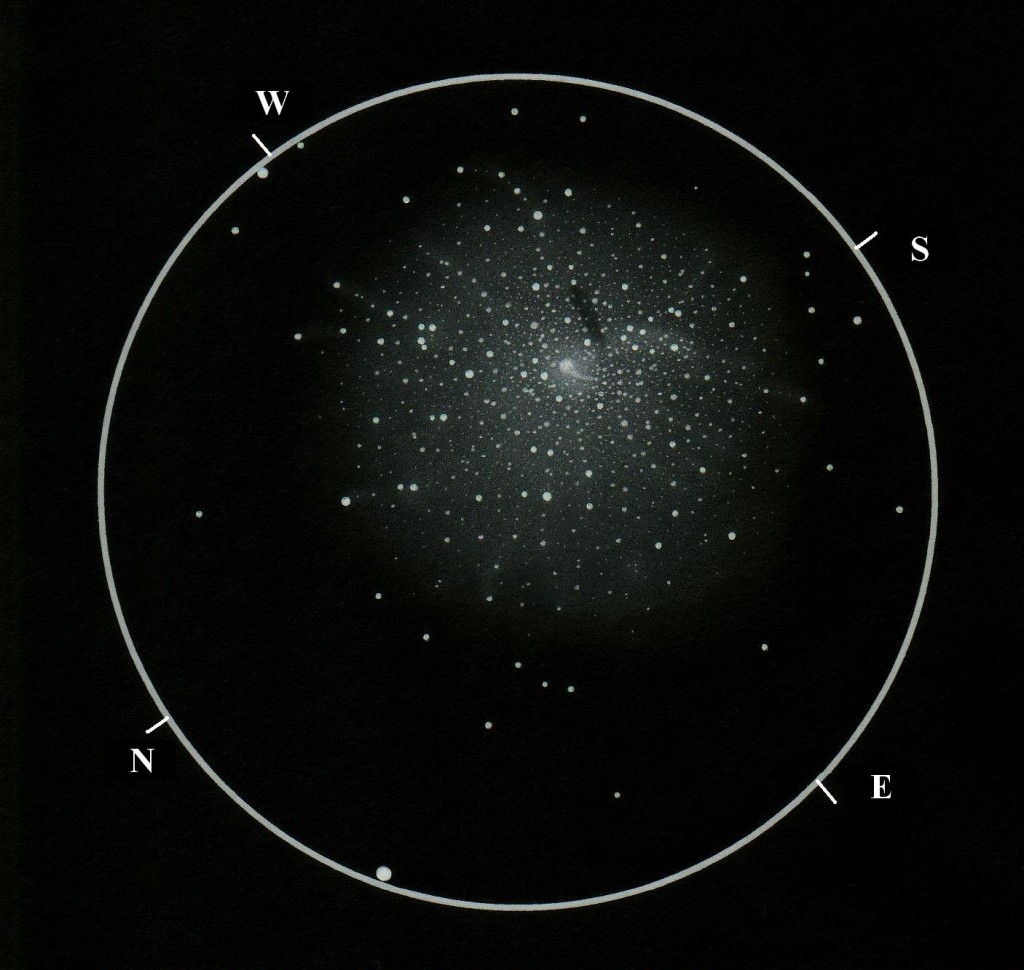
Object: Messier 15 (globular cluster, Pegasus)
Date: 12. 30. 2012.
UT.: 16h18m-17h46m
Equipment: 305/1525 Dobsonian telescope
Mag.: 218x
FOV: 12’
S = 8 / 10 T = 4 / 5
Observer: János Gábor Kernya
Location: Sükösd, Hungary
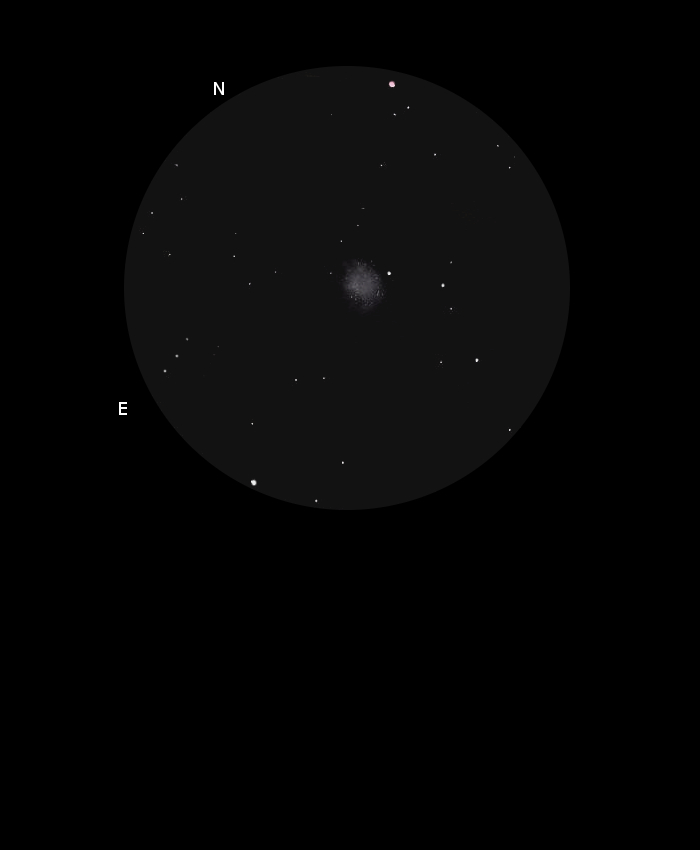
Nombre del Objeto: M-56; NGC 6779
Tipo de Objeto: Cúmulo Globular
Constelación: Lyra
Ubicación: La Hija de Dios, Ávila (España)
Fecha: 27-7-2014
Medios: Lapiz de grafito 0,5B, difumino, papel blanco y procesado con GIMP 2.8 para invertir
Magnitud visual 5 en el cenit con un cielo rural-urbano con noche estable y nada de viento
Telescopio: Refractor Acromático 152mm; F/7.9 sobre montura ecuatorial HEQ5 Pro y Ocular Televue 11mm; 109X; Campo Real: 1.1º
Saludos y gracias
Object Name: M-56; NGC 6779
Object Type: Globular Cluster
Constellation: Lyra
Location: The Daughter of God, Ávila (Spain)
Date: 27/07/2014
Media: Pencil graphite 0.5 B, stump, white paper and processed with GIMP 2.8 for inverting
Visual magnitude 5 on the peak with rural-urban night sky with stable and no wind
Telescope: Achromatic Refractor 152mm; F/7.9 on HEQ5 Pro equatorial mount and eyepiece Televue 11mm; 109X; Campo Real: 1.1 º
Greetings and thanks
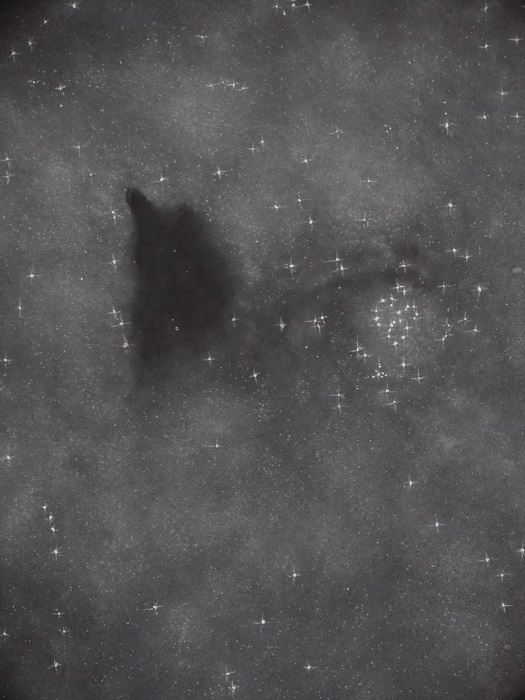
Hi all,
This was the first sketch I completed at Astrofest in Queensland, Australia. I’ve been wanting to sketch this beautiful dark nebula ever since I first laid eye on it some three years ago. This dark nebula, B86, goes by the popular name of “The Ink Spot”. It sits smack bang in the centre of the densest star cloud in the whole sky, the Cloud of Sagittarius. And what sets it off even more is B86 has a gorgeous bright open cluster right next to it, NGC 6570. Both objects are more-or-less the same size as each other, even though both are not very large themselves. But it is the juxtaposition of these two very different objects against the blaze of the Milky Way that makes this pair a spectacular pairing.
Dark nebulae are clouds of dust and gas that are drifting through the Milky Way galaxy. Many of these conglomerations of dust and gas do end up being formed into stars and planets, but most just end up forming the fabric of the galaxy. In fact, the stars that we see actually only form a small percentage of the actual mass of galaxies. By far the greatest amount of a galaxy’s mass comes from this very dust and gas. The Ink Spot is a small patch of cloud. It is a very opaque nebula too. Dark nebulae are categorised according to their opacity, or how dark they are. The scale of opacity goes from 1 (very tenuous) through to 6 (very opaque). While the opacity of The Ink Spot may be a 5, it is because that it sits in the Cloud of Sagittarius that makes is a striking object.
The little open cluster NGC 6520 really works very well in setting off B86. Open clusters are groupings of stars that are all related to each other having been formed out of the same parent cloud of gas and dust. Evidence for this is seen in the spectra of the stars displaying the same chemical make up. The brothers and sisters of our own Sun have been identified this way, with the same chemical signature as our Sun having been identified in several close by stars even though the Sun’s ‘siblings’ have long drifted off away from each other. Open clusters are loose groupings, so even though they formed from the same source, their gravitational connection to each other is not strong enough to keep the group together for too long.
For me, this tiny patch of sky is one of my most favourite. Tiny and oh so precious. Brilliant, dark, stark, ghostly. All in one. Gorgeous.
Alexander Massey.
Object: The Ink Spot, B86 & NGC 6570
Telescope: 17.5″ push-pull Karee dob
Gear: 13mm LVW, 154X
Location: Linville, Queensland, Australia
Date: 24th July, 2014
Media: Soft pastel, charcoal and white ink on A4 size black paper.
Duration: approx. 3hrs
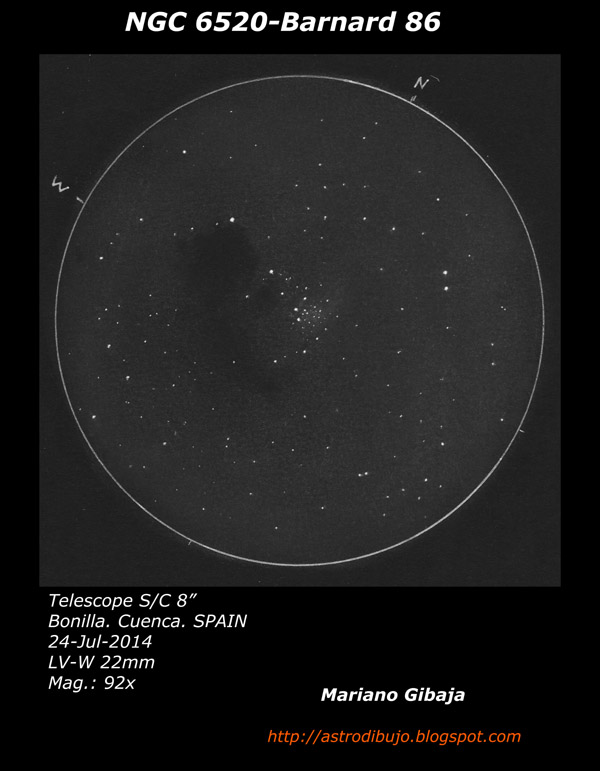
Object Name: NGC 6520 and Barnard 86.
RA: 18h 03m 25.1s; Dec: -27° 53′ 28″
Magnitude: 7.6
NGC 6520 size: 6′
Distance: 6,000 light-years approx.
Constellation: Sagittarius.
Type: Open Cluster and Dark Nebula.
Description NGC 6520: Cl, pS, Ri, lV, st 9 … 13
Location: Bonilla. Cuenca. SPAIN
Date: July 24, 2014.
Time: 00:10 UT.
Material used: pastel pencils and white ink on black paper. Inverted image with Photoshop.
Celestron Telescope S/C 8″ Mount Cgt-5
Eyepiece: LV-M 22mm; Magnification: 92x.
Condition: 21.39 SQM. Temperature: 16º. Humidity 29%. Calm wind.
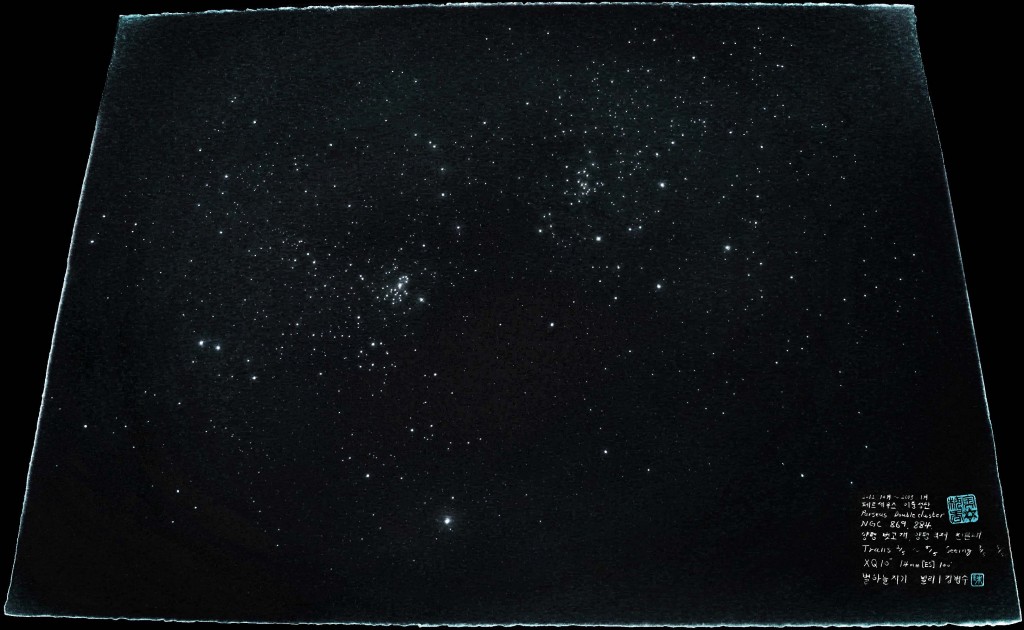
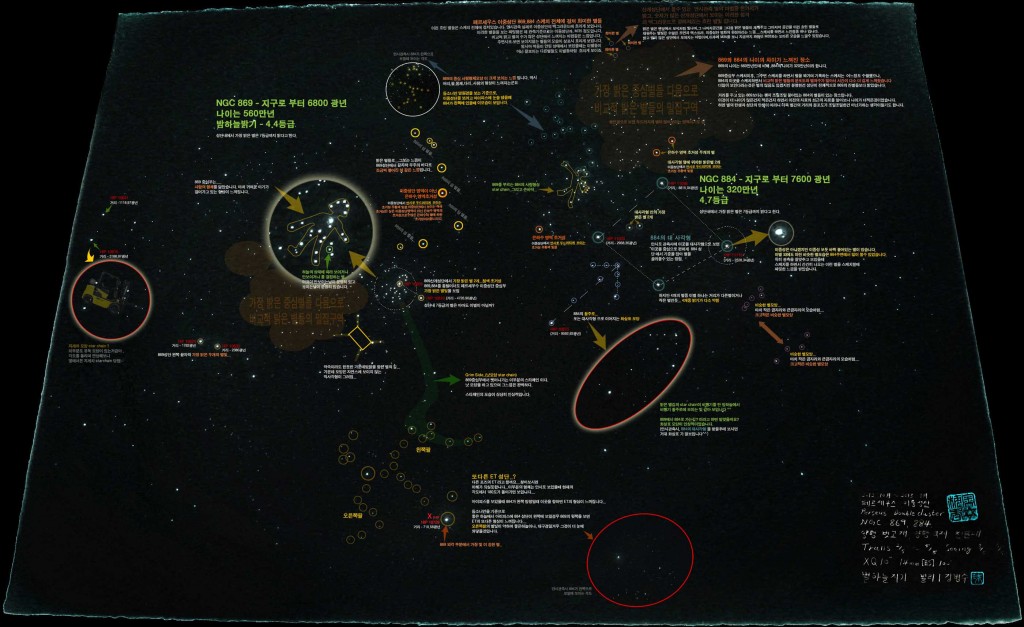
object Name – 3 months sketch ngc869 ngc884
[Location]
But-gogae Gosong-ri Yangdong-myeon Yangpyeong-gun Gyeonggi-do S.KOREA—–[6day observations]
International Observatory(Yard) Yongcheon-ri Yangpyeong-gun Gyeonggi-do S.KOREA—–[2day observations]
Media – pencil, charcoal
Paper – AQUARELLE ARCHES(Cold press)white Paper. [54.5cm x 78.8cm]
XQ 10″ Dob(f5) / ES 100′ 14mm “89x”
————————————————-
Perseus double cluster ngc869,ngc884
Under the night sky….
3 months sketch ngc869 ngc884..
2012. October start. 2013. January 11 END…..
click to image big size.
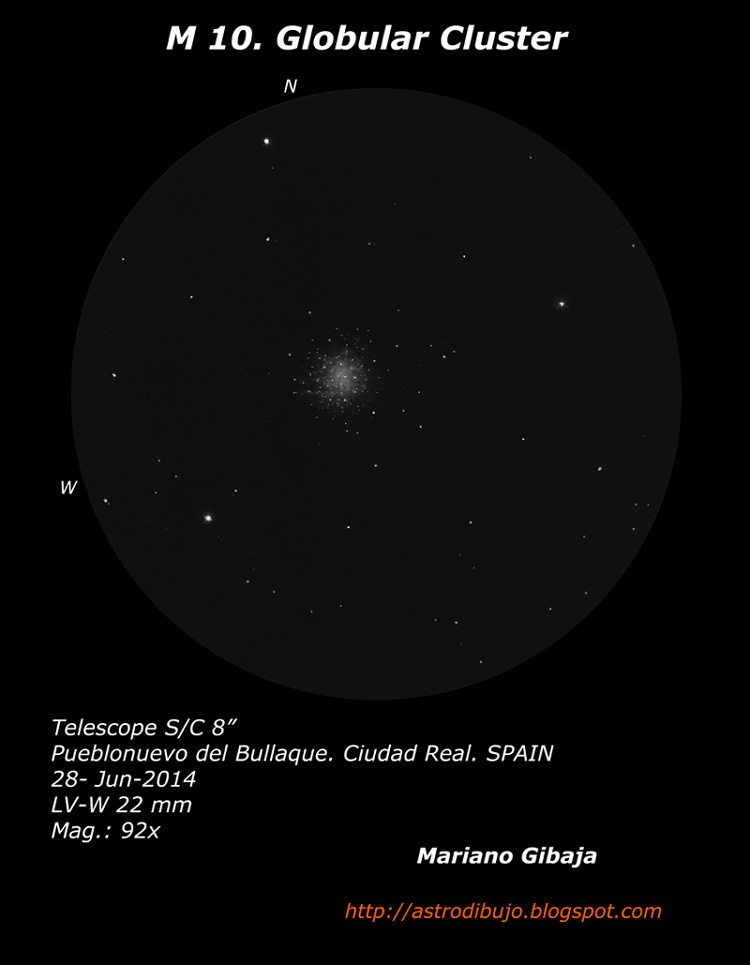
Object Name: M 10 (NGC 6254)
RA: 16h 57m 09.0s; Dec: -04° 05′ 58″
Magnitude: 6.6
Object size: 15′
Constellation: Ophiuchus
Type: Globular Cluster
Description: B, vL, R, gvmBM, rrr.
Location: Pueblonuevo del Bullaque. Ciudad Real. SPAIN
Date: June 28, 2014.
Time: 00:10
Material used: graphite pencils on white paper. Image processed with Photoshop.
Telescope S/C 8″ Mount Cgt-5
Eyepiece: LV-M 22mm; Magnification: 92x.
Condition: NEML: 5’8 (Zone 14 Cygnus); Temperature:13 º; Calm wind.
More information: http://astrodibujo.blogspot..com.es/
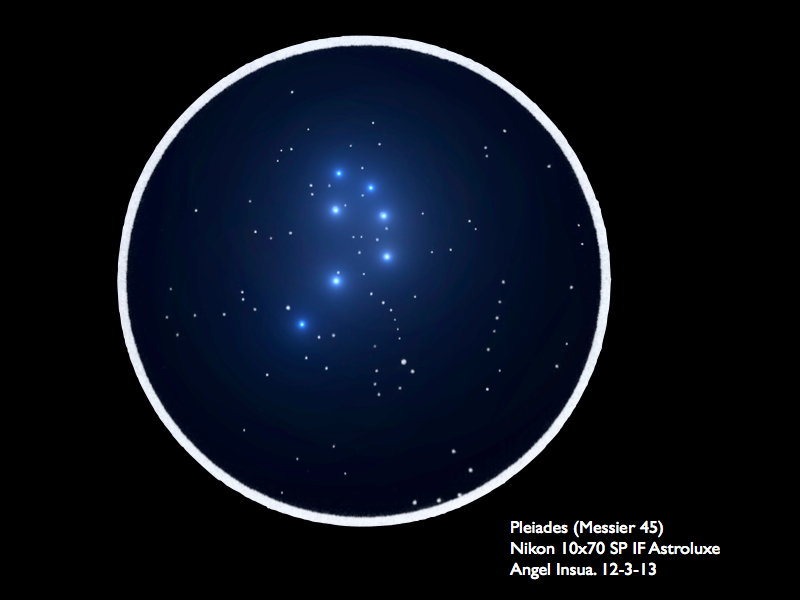
ASOD: ” The Pleiades”
Object Name: The Pleiades, Messier 45
Object Type: Open Cluster
Date: 12/3/2013
Location: A Coruña, Galicia. Spain.
Media: pencil, white paper, color invert and enhance with Gimp.
Nikon Astroluxe 10×70
Seein: 3/5 (good)
One of our favourite cluster, M45 is a real handful of gems in the sky.
The sketch was done in two steps. I did the main draw in first night and correct some positions in the second night.